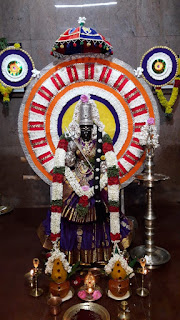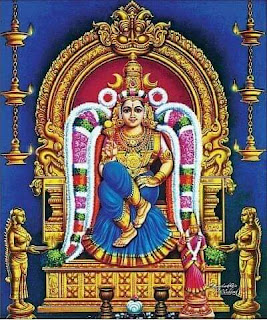After describing yogini-s, Vāc Devi-s continue with their description of Lalitāmbikā.
स्वाहा (535)
Svāhā
Lalitāmbikā is in the form of oblations offered to gods and goddesses. The mantra-s for such oblations end with svāhā.
स्वधा (536)
Svadhā
She is in the form of oblations offered to the departed souls of ancestors (pitṛ) and such mantra-s end with svadhā.
It is also said that Svāhā and Svadhā are the two wives of Lord Agni.
अमतिः (537)
Amatiḥ
She is in the form of avidyā or ignorance. The creation in the beginning was devoid of consciousness, known as avyakta form . The intellect in such un-manifested stage is known as amati.
मेधा (538)
Medhā
She in the form of amati, transforms into medha or intelligence, along with evolution. This is also to confirm Her existence from the beginning of creation.
श्रुतिः (539)
Śrutiḥ
Śruti means Veda-s. She is in the form of all the four Veda-s.
स्मृतिः (540)
Smṛtiḥ
Smṛti-s, derived from Veda-s deliver the message of the Brahman in understandable terms. She is in the form of such Smṛti-s. Smṛti also refers to the power of recollection and memory. Upaniṣads are classified under Smṛti-s.
अनुत्तमा (541)
Anuttamā
No one is superior to Her, an exclusive of the qualitiy of the Brahman. Anuttamā also means intellect not derived from others. She is the embodiment of intellect.
पुण्यकीर्तिः (542)
Puṇyakīrtiḥ
She is known for virtues. She gives fame to Her devotees. The very thought of Her, sanctifies a person.
पुण्यलभ्या (543)
Puṇyalabhyā
She is attainable through virtues. Puṇya means virtues. It is said that ‘She is attained by those who are virtuous and have knowledge of Veda-s.
पुण्य-श्रवण-कीर्तना (544)
Puṇya-śravaṇa-kīrtanā
Recitation of verses in praise of Her (like this Lalitā Sahasranāma), or listening to such praises are virtuous acts.
पुलोमजार्चिता (545)
Pulomajārcitā
Puloman is a demon. His daughter is Indrani, wife of Indra. She's celebrated for her purity and chastity. She's an ardent devotee of Lalithai. This nama says that Lalithai is worshipped by the daughter of Puloman.
बन्ध-मोचनी (546)
Bandha-mocanī
She liberates from bondage.
बर्बरालका (547)
Barbarālakā
In some texts, this nāma is mentioned as bandhūrālakā. She has curly hair that appears like waves and flowing into Her forehead.
विमर्श-रूपिणी (548)
Vimarśa-rūpiṇī
The reflection of Śiva is known as vimarśa, which is known as Śaktī. Without the presence of vimarśa or Śaktī, Śiva cannot act. Śiva is the creator and Śaktī is the doer. This nama emphasizes Her creative aspect.
विद्या (549)
Vidyā
Vidyā means ‘to deliberate’. She is the giver of knowledge that is capable of providing final liberation. This is an extension of the previous nāma.
वियदादि-जगत्-प्रसूः (550)
Viyadādi-jagat-prasūḥ
She is the Creator of the five principles of Universe starting with ākāś (ether) air, etc.
सर्व-व्याधि-प्रशमनी (551)
Sarva-vyādhi-praśamanī
She cures all diseases.
सर्व-मृत्यु-निवारिणी (552)
Sarva-mṛtyu-nivāriṇī
Mṛtyu means death. There are different types of deaths such as premature death arising out of accidents, disease or untimely deaths. The death here indicates the final liberation of the soul to merge with the Brahman. The nāma means that She is liberator of such souls.
अग्र-गण्या (553)
Agra-gaṇyā
She is the First, first among the entire creation.
अचिन्त्य-रूपा (554)
Acintya-rūpā
She is in inconceivable form, a quality of the Brahman.
कलि-कल्मष-नाशिनी (555)
Kali-kalmaṣa-nāśinī
She destroys the sins committed during kali yug. Kali, began at midnight between the 17th and 18th of Feb. 3102 B. C.
Currently we are going through 5111th year of kali yug ((2010-11) out of 360,000 human years. 360 human years is equal to one divine year. 12,000 divine years (4,320,000 human years) consists the four ages called Kṛita yug (4000 divine years), Tretā yug (3000 divine years), Dvāpara yug (2000 divine years) and Kali yug (1000 divine years). The balance of 2000 divine years has been calculated for twilight period of each yug.” Out of the four, kali yug is supposed to have more sinners and She in the form of Goddess Kali destroys sins.
कात्यायनी (556)
Kātyāyanī
She is the sum total of the effulgence (tejas) of all gods and goddesses.
She who is the daughter of the sage named Kata.
कालहन्त्री (557)
Kālahantrī
Kāla means death. She is the destroyer of death.
कमलाक्ष-निषेविता (558)
Kamalākṣa-niṣevitā
She is worshiped by Viṣṇu, the lotus eyed.
ताम्बूल-पूरित-मुखी (559)
Tāmbhūla-pūrita-mukhī
She is fond of chewing betel leaves with karpūra vīṭikā (nāma 26). The betel leaves turn Her lips into red colour.
दाडिमी-कुसुम-प्रभा (560)
Dāḍimī-kusuma-prabhā
She radiates like a pomegranate flower. They are dark red in colour. The flowers of pomegranate are considered as the most auspicious amongst the flowers for worshipping Her. Next is hibiscus flower, which too has deep red petals and is widely used for worshipping Her.
मृगाक्षी (561)
Mṛgākṣī
Her eyes appear like that of a deer.
मोहिनी (562)
Mohinī
She bewitches. Unable to find proper words to describe Her beauty, Vāc Devi-s used this word. Bewitchment is not possible without being splendiferous. She is the beauty incarnate, because Her beauty is made up of knowledge, efficiency and compassion.
मुख्या (563)
Mukhyā
She is the first in the universe. Mukhya also means important. She is authoritative amongst all gods and goddesses.
मृडानी (564)
Mṛḍānī
Mṛḍa means Śiva. Consort of Mṛḍa is Mṛḍānī.
मित्र-रूपिणी (565)
Mitra-rūpiṇī
Mitra means a friend. Sun is considered as a friend of the universe, as it sustains existence.
नित्य-तृप्ता (566)
Nitya-tṛptā
She remains eternally contended, because She has no requirements.
भक्त-निधिः (567)
Bhakta-nidhiḥ
She is the treasure house for Her devotees.
नियन्त्री (568)
Niyantrī
She is the guide to the universe. Since She administers the universe, She is addressed in this nāma as its guide.
निखिलेश्वरी (569)
Nikhileśvarī
She assumes the position of Supreme Ruler. Nikhila means complete or total.
मैत्र्यादि-वासना-लभ्या (570)
Maitryadi-vāsanā-labhyā
She can be attained through qualities like kindness, etc.
महा-प्रलय-सक्षिणी (571)
Mahā-pralaya-sakṣiṇī
Mahā-pralaya is the total dissolution.
When annihilation unfolds, the entire universe gets dissolved into Śiva. This happens exactly in the reverse process of creation. At the time of creation ākāś was born out of the Brahman, air was born out of ākāś, etc. At the time of annihilation, air gets dissolved into ākāś and ākāś gets dissolved into Śiva. This process is known as involution as opposed to evolution, a process that happens during creation.
This nāma says that She is the only witness to the great dissolution.
पराशक्तिः (572)
Parāśaktiḥ
She is Parāśaktī. Consort of Paramaśiva is Parāśaktī.
परा-निष्ठा (573)
Parā-niṣṭhā
Niṣṭha means steadfast position. The mind of a self realized person becomes steadfast, perpetually united with the Brahman. For reaching this stage, the highest level of knowledge is required. She is in the form of parā-niṣṭhā. Without Her help, reaching this stage is not possible. She is the embodiment of power (parā-śaktī) and knowledge (parā-niṣṭhā).
प्रज्ञान-घन-रूपिणी (574)
Prajñāna-ghana-rūpiṇī
Prajāna-ghana-rūpiṇī means concentration of superior knowledge. Superior concentrated knowledge means the knowledge that remains unpolluted by ignorance.
माध्वीपानालसा (575)
Mādhvīpānālasā
She is in a state of samādhi and enjoying the ultimate bliss. She always meditates on Her creator Śiva.
मत्ता (576)
Mattā
She always meditates on Her creator Śiva. During the higher levels of kuṇḍalinī meditation, a honey like fluid, generally called ambrosia drips into throat. Because of its taste and viscosity it resembles honey. It is known as spiritual intoxicant and said to possess intoxicating qualities. Because of consuming the drink, She is in the stage of intoxication.
मातृका-वर्ण-रूपिणी (577)
Matṛkā-varṇa-rūpinī
She is in the form of 51 alphabets of Sanskrit called matṛkā.
महा-कैलास-निलया (578)
Mahā-kailāsa-nilayā
Mahā-kailāsa is the abode of Śiva. This is far away from the existing Kailāsa mountains. In fact, mahā-kailāsa is beyond human comprehension.
मृणाल-मृदु-दोर्लता (579)
Mṛuṇāla-mṛdu-dorlatā
Her arms are tender like lotus stalks.
महनीया (580)
Mahānīyā
She is adorable.
दयामूर्ति: (581)
Dayāmūrtīh
She is the embodiment of compassion.
महा-साम्राज्य-शालिनी (582)
Mahā-sāmrājya-śālinī
She magnificently controls all the planets forming part of this universe.















No comments:
Post a Comment